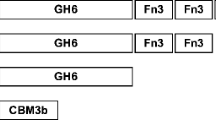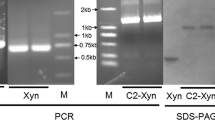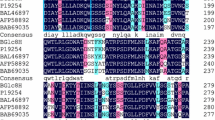Abstract
The nucleotide sequence of a chromosome fragment of the thermophilic anaerobic bacterium Caldicellulosiruptor bescii (syn. Anaerocellum thermophilum) has been determined. The fragment contains four open reading frames with the second encoding a 749 aa multimodular endo-1,4-β-glucanase CelD (85019 Da). The N-terminal region of the protein includes a signal peptide and a catalytic module of glycoside hydrolase family 5 (GH5), followed by a carbohydrate-binding module of family 28 (CBM28). The C-terminal region bears three SLH modules. The recombinant endoglucanase and its two separate modules, the catalytic module and CBM28, were produced in E. coli cells and purified to homogeneity. An analysis of the catalytic properties showed CelD to be an endo-1,4-β-glucanase with maximum activity on barley β-glucan at pH 6.2 and 70°C. The enzyme was stable at 50°C for 30 days. Upon removal of the C-terminal CBM28, the activity of GH5 was decreased on cellulose substrates, and its thermostability has dropped. Binding of CBM28 to amorphous cellulose has been almost irreversible as it could not be removed from this substrate in a range of pH of 4–11, temperatures of 0–75°C, and NaCl concentrations of 0–5 M. Only 100% formamide or 1% SDS have been able to remove the protein.
Similar content being viewed by others
Abbreviations
- GH:
-
glycoside hydrolase
- SP:
-
signal peptide
- Cat5:
-
catalytic module of glycoside hydrolase family 5
- CBM28:
-
carbohydrate-binding module of family 28
- SLH:
-
surface-layer homology module
- BCC:
-
bacterial crystalline cellulose
- PAG:
-
polyacrylamide gel
- CMC:
-
carboxymethyl cellulose
- SDS:
-
sodium dodecyl sulfate
References
Tomme P., Warren R.A.J., Gilkes N.R. 1995. Cellulose hydrolysis by bacteria and fungi. Adv. Microb. Physiol. 37, 1–81.
Zverlov V.V., Schwarz W.H. 2008. Bacterial cellulose hydrolysis in anaerobic environmental systems Clostridium thermocellum and Clostridium stercorarium, thermophilic plant fibre degraders. In: Incredible Anaerobes: From Physiology to Genomics to Fuels. Eds. Wiegel J., Maier R.J., Adams M.W.W. Ann. N.Y. Acad. Sci. 1125, 298–307.
Boraston A.B., Bolam D.N., Gilbert H.J., Davies G.J. 2004. Carbohydrate-binding modules: Fine tuning polysaccharide recognition. Biochem. J. 382, 769–781.
Schwarz W.H., Zverlov V.V., Bahl H. 2004. Extracellular glycosyl hydrolases from clostridia. Adv. Appl. Microbiol. 56, 215–261.
Karita S., Sakka K., Ohmyia K. 1996. Cellulose-binding domains confer an enhanced activity against insoluble cellulose to Ruminococcus albus endoglucanase 1V. J. Ferment. Bioeng. 81, 553–556.
Svetlichnii V.A., Svetlichnaya T.P., Chernikh N.A., Zavarzin G.A. 1990. Anaerocellum thermophilum, gen. nov., sp. nov., an extremely thermophilic cellulolitic eubacterium isolated from hot-springs in the Valley of the Geysers. Microbiology. 59, 598–604.
Yang S.J., Kataeva I., Wiegel J., Yin Y., Dam P., Xu Y., Westpheling J., Adams M.W. 2010. Classification of Anaerocellum thermophilum strain DSM 6725 as Caldicellilosiruptor bescii sp. nov. Int. J. Syst. Evol. Microbiol. 60, 2011–2015.
Kataeva I.A., Yang S.J., Dam P., et al. 2009. Genome sequence of the anaerobic, thermophilic and cellulolitic bacterium Anaerocellum thermophilum DSM 6725. J. Bacteriol. 191, 3760–3761.
Blumer-Schuette S.E., Ozdemir I., Mistry D., et al. 2011. Complete genome sequences for the anaerobic extremely thermophilic plant biomass-degrading bacteria Caldicellilosiruptor hydrotermals, Caldicellilosiruptor kristianssonii, Caldicellilosiruptor kronotskyensis, Caldicellilosiruptor owensensis, and Caldicellilosiruptor lactoaceticus. J. Bacteriol. 193, 1483–1484.
Cantarel B.L., Coutinho P.M., Rancurel C., Bernard T., Lombard V., Henrissat B. 2009. The Carbohydrate-Active EnZymes database (CAZy): An expert resourse for glycogenomics. Nucleic Acids Res. 37, D233–D238.
Blumer-Schuette S.E., Levis D. L., Kelly R.M. 2010. Phylogenetic, microbiological and glucoside hydrolase diversities within the extremely thermophilic, plant biomass-degrading genus Caldicellilosiruptor. Appl. Environ. Microbiol. 76, 8084–8092.
Teo V.S., Saul D.J., Bergqwist P.L. 1995. celA, another gene coding for a multidomain cellulase from the extreme thermophile Caldocellum saccharalyticus. Appl. Microbial. Biotechnol. 43, 291–295.
Zverlov V., Mahr S., Riedel K., Bronnenmeier K. 1998. Properties and gene structure of bifunctional cellulolitic enzyme (CelA) from the extreme thermophile Anaerocellum thermophilum with separate glycosyl hydrolase family 9 and 48 catalytic domains. Microbiology. 144, 457–465.
Su X., Mackie R.I., Cann I.K. 2012. Biochemical and mutational analysis of a multidomain cellulase/mannanase from Caldicellilosiruptor bescii. Appl. Environ. Microbiol. 78, 2230–2240.
Bolchakova E.V., Ponomarev A.A., Novikov A.A., Svetlichnyi V.A., Velikodvorskaya G.A. 1994. Cloning and expression of genes coding for carbohydrate degrading enzymes of Anaerocellum thermophilum in E. coli. Biochem. Biophys. Res. Commun. 202, 1076–1080.
Wood T.M., Bhat K.M. 1988. Methods for measuring of cellulase activities. Methods Enzymol. 160, 87–112.
Zverlov V.V., Schantz N., Schwarz W.H. 2005. A major new component in the cellulosome of Clostridium thermocellum is a processive endo-beta-1,4-glucanase producing cellotetraose. FEMS Microbiol. Lett. 249, 353–358.
Zverlov V.V., Volkov I.Y., Velikodvorskaya G.A., Schwarz W.H. 2001. The binding pattern of two carbohydrate-binding modules of laminarinase Lam16A from Thermotoga neapolitana: Differences in beta-glucan binding within family CBM4. Microbiology. 147, 621–629.
Jamal S., Nurizzo D., Boraston A. B., Davies G.J. 2004. X-ray crystal structure of a non-crystalline cellulosespecific carbohydrate-binding module: CBM28. J. Mol. Biol. 339, 253–258.
Araki Y., Karita Sh., Tanaka A., Kondo M., Goto M. 2009. Characterization of family 17 and family 28 carbohydrate-binding modules from Clostridium josui Cel5A. Biosci. Biotechnol. Biochem. 73, 1028–1032.
Velikodvorskaya G.A., Zverlov V.V., Karyagina-Zhulina A.S., Lavrova N.V., Lunin V.G., Lunina N.A., Ryazanova E.M., Sergienko O.V., Tikhonova T.V. 2006. RF Patent no. RU2278160 (C2).
Velikodvorskaya G.A., Tikhonova T.V., Gurvits I.D., Karyagina A.S., Lavrova N.V., Sergienko O.V., Tashlitskii V.N., Lunina N.A., Lunin V.G. 2010. Chimeric lactase capable of spontaneous and strong immobilization on cellulose and development of continuous-flow system for lactose hydrolysis at high temperatures. Appl. Envir. Microbiol. 76, 8071–8075.
Author information
Authors and Affiliations
Corresponding author
Additional information
Original Russian Text © G.A. Velikodvorskaya, L.A. Chekanovskaya, N.A. Lunina, O.V. Sergienko, V.G. Lunin, I.A. Dvortsov, V.V. Zverlov, 2013, published in Molekulyarnaya Biologiya, 2013, Vol. 47, No. 4, pp. 667–673.
Rights and permissions
About this article
Cite this article
Velikodvorskaya, G.A., Chekanovskaya, L.A., Lunina, N.A. et al. Family 28 carbohydrate-binding module of the thermostable endo-1,4-β-glucanase CelD from Caldicellulosiruptor bescii maximizes enzyme activity and irreversibly binds to amorphous cellulose. Mol Biol 47, 581–586 (2013). https://doi.org/10.1134/S0026893313040158
Received:
Accepted:
Published:
Issue Date:
DOI: https://doi.org/10.1134/S0026893313040158




